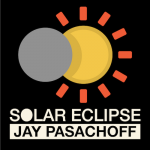Podcaster: Jay Pasachoff
 Title: Tomorrow’s Total Solar Eclipse in the United States
Title: Tomorrow’s Total Solar Eclipse in the United States
Organization: Williams College and Caltech
Links: http://www.eclipses.info and http://www.totalsolareclipse.org
Description: It is time for Total Solar Eclipse 2017
Bio: Jay Pasachoff, Chair of the International Astronomical Union’s Working Group on Eclipses, is Field Memorial Professor of Astronomy at Williams College and a Visitor at Caltech. He has viewed 64 solar eclipses, and is an expert on both their use for scientific observations and their use for public education. Pasachoff is a former president of the International Astronomical Union’s Commission on Education and Development and Chair of the Historical Astronomy Division of the American Astronomical Society. He received the Education Prize of the American Astronomical Society, the Janssen Prize of the Société Astronomique de France, and this year’s Richtmyer Memorial Lecture Award from the American Association of Physics Teachers. Pasachoff is the author or co-author of The Cosmos: Astronomy in the New Millennium, the Peterson Field Guide to the Stars and Planets, and Nearest Star: The Surprising Science of Our Sun plus, on a more technical level, The Solar Corona, as well as a new, 2017 book, The Sun, for the Science Museum, London.
Today’s sponsor: This episode of “365 Days of Astronomy” is sponsored by — no one. We still need sponsors for many days in 2014, so please consider sponsoring a day or two. Just click on the “Donate” button on the lower left side of this webpage, or contact us at signup@365daysofastronomy.org.
Transcript:
The August 21st 2017 total solar eclipse isn’t especially meaningful in any astronomical sense but it does go across the United States. The totality goes from upper left to lower right of the Continental United States and a lot is being made of that, and, of course ,a lot of people will be there in the United States to see it. Still, the 2009 eclipse went near Shanghai; the 1991 eclipse went across Mexico City: so there have been other eclipses that went across big urban areas.
Anyway, this one is on August 21st at the peak of the summer. The temperature last week was up to 109 degrees or 44 Celsius in that region of Oregon, so especially hot. It’s calculated to cool down quite a lot by the time of the eclipse and of course you will have an actual cloudiness and weather statistic for the day. In any case, the statistics going back 20 years of weather satellites indicated that the most favorable region of the United States in terms of low cloudiness was the northwestern United States–in particular, Idaho and Oregon–and so many people are going there, and to Wyoming. The southeastern United States is usually cloudier in the afternoon of August 21st and still there will be a lot of people there.
Anyway, scientifically this is a valuable eclipse–as they all are–because we get a view of the middle and lower corona in white light. This is the only way we can do that well. There is some overlap with the coronagraph on the Mauna Loa observatories site in Hawaii but that is much lower resolution than we see. It’s fainter than the blue sky and what happens at an eclipse is that the blue sky falls away and we can see the corona in all its glory. We can see all the shapes that are held in by the magnetic field. At this eclipse, in particular, it will be near solar minimum so the streamers will be largely equatorial and the plumes will be visible at the poles. The last few eclipses were closer to solar maximum and so there were streamers at high latitudes and you couldn’t see the polar plumes.
There are a variety of people all across the United States, scattered along the whole path, taking images of various kinds. We in my own group will have a site in Salem, Oregon, with support from the US National Science Foundation and the National Geographic Society especially, with a number of students and colleagues who study imaging, including imaging at very high resolution in coronal loops through the special filters that pass only the very hot gas from iron 14 (13 times ionized iron). and iron 10 (9 times ionized Iron). We will be looking at 5 hertz, five times a second, to see a test of the various models of how the corona is heated to a million degrees.
The partial phases extend through all of North America into the top part of South America, even over into Siberia and parts of Europe, and so many people will have a partial eclipse. But we have been trying to explain to them the difference between the partial eclipse, in which nothing happens really very exciting, and the glories of a total solar eclipse.
Then we start looking forward to the next couple of total eclipses, both in South America on July 2nd 2019, now less than 2 years away, which ends over Chile, and really ends in Argentina, and then the following year on December 14th 2020, when there will be a total solar eclipse whose path crosses Argentina and Chile.
End of podcast:
365 Days of Astronomy
=====================
The 365 Days of Astronomy Podcast is produced by Astrosphere New Media. Audio post-production by Richard Drumm. Bandwidth donated by libsyn.com and wizzard media. You may reproduce and distribute this audio for non-commercial purposes. Please consider supporting the podcast with a few dollars (or Euros!). Visit us on the web at 365DaysOfAstronomy.org or email us at info@365DaysOfAstronomy.org. This year we will celebrate more discoveries and stories from the universe. Join us and share your story. Until tomorrow! Goodbye!

